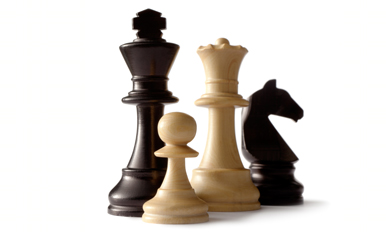
The numbers are so basic, yet so captivating. Thirty-two pieces. Sixty-four squares. More possible unique games than electrons in the universe. No one knows exactly where or when the game of chess was invented, but it’s been enthralling people for more than a millennium.
It captured the imagination of Robert Lazorchak, CAS/MA ’14, at age seven, when his father taught him to play. Lazorchak didn’t dive into the world of competitive chess until he moved to Washington before grad school. While taking night classes at AU, he also began teaching the game to elementary school kids. After earning his master’s in elementary education, Lazorchak landed a job as a full-time chess teacher in New York City.
“Everyone focuses on the cognitive benefits, and I think that’s true,” he says of the game’s benefits for children. “It teaches people critical thinking skills, pattern recognition, how to follow a logical sequence of ideas. But I think a lot of people overlook the social benefits to chess. It really helps children with impulse control—not playing the first move they see. It teaches them to take responsibility for their decisions.”
Last spring, Lazorchak and his family moved to Madison, New Jersey, where he started Diplomat Chess. The company teaches the game to more than 300 children (kindergartners to eighth graders) in the Garden State. He’s a Class A player—a lofty rating—but he’s already been surpassed by at least one of his former pupils, who is ranked in the top five in the country for fourth graders.
“He has beaten me,” Lazorchak says, more proudly than sheepishly. “He’s now playing at a really prestigious private school in Manhattan. The accomplishment is totally his own, but it felt nice knowing that I was a tiny part of that.”
Chess is a beautiful—but brutal—game. A player can be dominating a match, but one misstep can lead to immediate defeat, Lazorchak says.
“That’s resulted in countless meltdowns, but it’s really a teachable moment for kids to learn to take responsibility for their actions,” he says. “There’s a famous chess saying: ‘When you see a good move, look for a better one.’”
Lazorchak explains the three most popular opening moves in chess:
- King’s pawn to e4: “Favored by Bobby Fischer because the pawn occupies the center and activates two pieces. Now the bishop can come out and so can the queen, diagonally.”
- Queen’s pawn to d4: “Unlocks the other bishop and frees the queen to go up the board vertically. The queen and the pawn are aiming at the center, and the bishop is wide open.”
- King’s knight to f3: “Develops a piece, controls the center, and brings you one step closer to castling.”